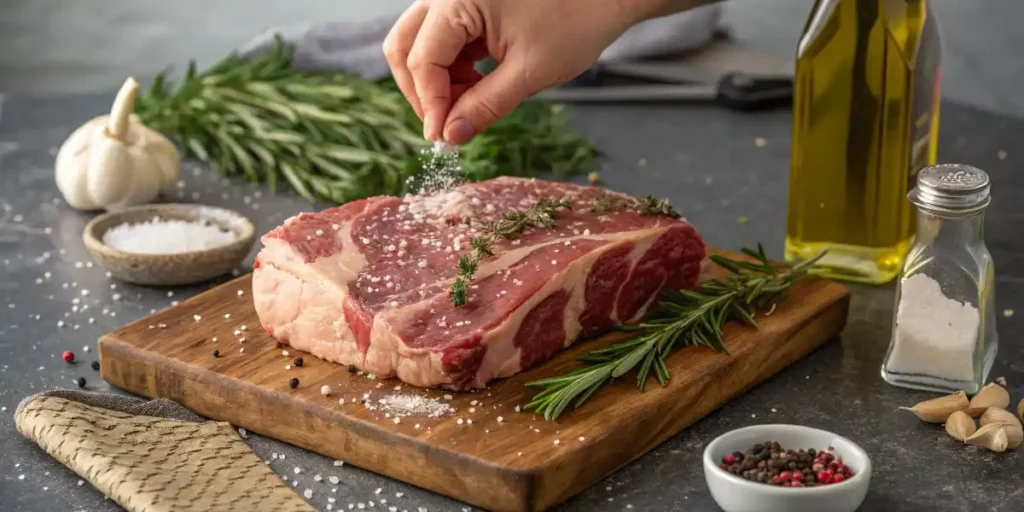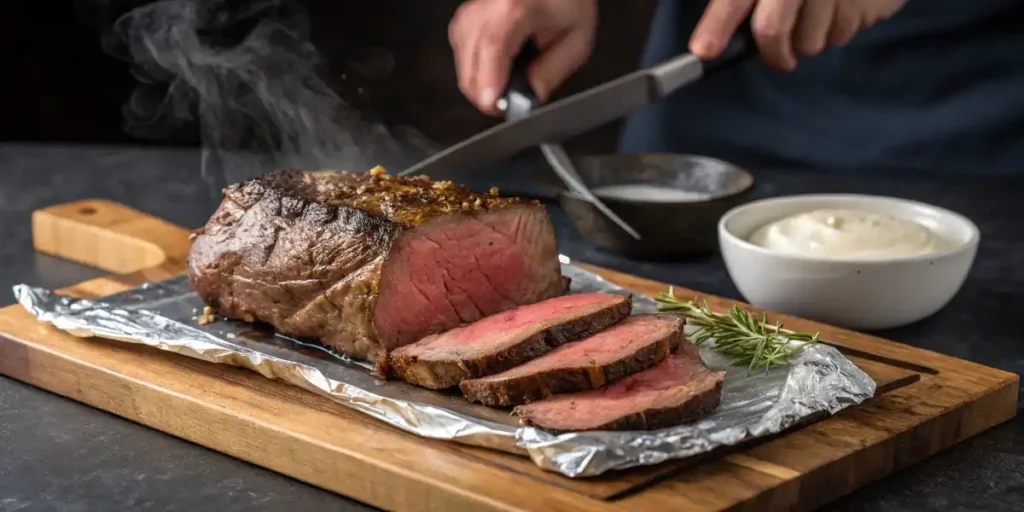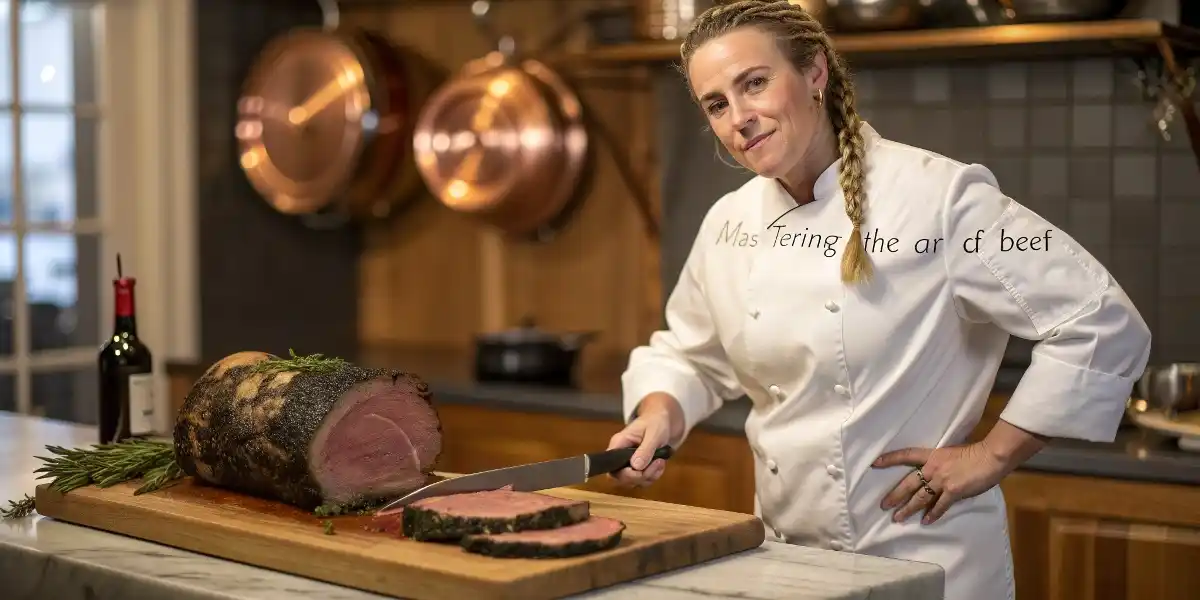A perfectly cooked ribeye roast is the ultimate showstopper—a tender, juicy, and flavorful cut of beef that melts in your mouth. Whether you’re preparing it for a holiday feast or a special family dinner, mastering this roast will impress everyone at the table.
In this guide, we’ll walk you through everything you need to know about making the best ribeye roast recipe from start to finish. You’ll learn:
- How to choose the perfect ribeye roast
- The best seasonings and cooking techniques
- Oven-roasting, slow-cooking, and rotisserie methods
- Temperature and doneness tips
- Common mistakes to avoid
- Answers to frequently asked questions
Let’s get started with the basics!
Table of Contents
Understanding the Ribeye Roast
A ribeye roast is one of the most sought-after beef cuts, thanks to its exceptional marbling and rich flavor. But what makes this roast so special, and how does it compare to other cuts like prime rib? Let’s break it down.
What Is a Ribeye Roast?
The ribeye roast is a boneless cut taken from the rib section of the cow, between ribs six and twelve. It’s the same cut used for ribeye steaks, just in its whole, uncut form. Because of its high-fat content and marbling, it remains juicy and tender even after roasting.
This cut is often confused with prime rib, but while they come from the same part of the cow, there are some key differences.
Ribeye Roast vs. Prime Rib: What’s the Difference?
People often ask, “Is a ribeye roast the same as a prime rib roast?” The answer: Not exactly.
- Prime rib is typically bone-in and cooked as a large roast, while ribeye roast is usually boneless.
- The cooking methods differ—prime rib is often slow-roasted at a low temperature, whereas ribeye roast can be cooked faster due to its smaller size.
- Prime rib has a slightly more dramatic presentation, but the ribeye roast offers the same flavor-packed experience in a more convenient form.
Why Ribeye Is a Great Choice for Roasting
So, why should you choose a ribeye roast over other cuts like a chuck roast or sirloin roast?
- Superior marbling – More fat means a juicier, more flavorful roast.
- Tender texture – Unlike tougher cuts, it doesn’t require hours of slow cooking to become tender.
- Versatile cooking options – Whether you want to roast, grill, or cook it in a rotisserie, this cut adapts well.
Now that you know what makes a ribeye roast so special, let’s move on to selecting the perfect cut!
Choosing the Perfect Ribeye Roast
Before cooking an amazing ribeye roast recipe, you need to start with the right cut of meat. Selecting a high-quality roast ensures the best flavor, tenderness, and texture.
Bone-in vs. Boneless Ribeye Roast
One of the first choices you’ll make is whether to go bone-in or boneless. Both options have their advantages:
✔ Bone-in ribeye roast – The bone adds extra flavor and helps insulate the meat, making it juicier. It also makes for a stunning presentation.
✔ Boneless ribeye roast – Easier to carve and slightly quicker to cook. It still delivers incredible taste, thanks to its marbling.
If you’re cooking for a crowd and want easy slicing, go for boneless. But if you want maximum juiciness, a bone-in ribeye roast recipe is worth it.
How to Select the Best Cut: Marbling, Grade, and Freshness
When buying a ribeye roast, look for these key factors:
- Marbling: The more white flecks of fat within the meat, the juicier and more flavorful the roast.
- Beef Grade: USDA Prime is the best quality, with the most marbling. Choice is slightly leaner but still delicious. Avoid Select, as it lacks fat and flavor.
- Freshness: Look for a bright red color with firm texture and avoid any meat that looks discolored or has an off smell.
How Many Pounds of Ribeye Roast Per Person?
A good rule of thumb is ½ to ¾ pound per person for a boneless roast and ¾ to 1 pound per person for bone-in. If you want leftovers (which you will!), consider adding an extra pound or two.
Now that you’ve got the perfect cut, it’s time to prepare it for roasting!
Preparing the Ribeye Roast for Cooking

The secret to an unforgettable ribeye roast recipe is proper preparation. Seasoning, searing, and allowing the meat to rest before cooking make a world of difference in flavor and texture.
How to Season a Ribeye Roast for Maximum Flavor
A simple seasoning blend brings out the natural richness of a ribeye roast. Here’s a classic, foolproof mix:
- 2 tablespoons kosher salt
- 1 tablespoon black pepper
- 1 tablespoon garlic powder
- 1 teaspoon paprika
- 1 teaspoon rosemary or thyme (optional)
Generously coat the roast on all sides and let it sit at room temperature for at least 1 hour before cooking. This allows the seasoning to penetrate the meat.
Should You Sear a Ribeye Roast Before Cooking?
Yes! Searing locks in juices and creates that irresistible crust. Follow these steps:
- Heat a cast-iron skillet over high heat with a little oil.
- Sear the roast on all sides for 2-3 minutes per side until it forms a golden-brown crust.
- Remove from heat and prepare for roasting.
How to Get a Perfect Crust on a Ribeye Roast
Want an extra-crispy, flavorful crust? Try these tips:
- Use butter and garlic – Melted butter brushed over the roast before searing enhances browning.
- Reverse sear method – Roast at a low temp first (250°F), then blast it at 500°F for a few minutes at the end.
- Dry aging – Leaving the roast uncovered in the fridge for a day or two helps intensify flavor and crust.
With your ribeye roast recipe properly prepped, it’s time to explore the best cooking methods in the next section!
Cooking Methods for Ribeye Roast
There are several ways to cook a ribeye roast recipe, each bringing out unique flavors and textures. Whether you prefer the classic oven roast or a smoky rotisserie style, these methods will help you achieve a juicy, tender roast every time.
Oven-Roasting: Step-by-Step Guide
Oven-roasting is the most traditional and foolproof method for a ribeye roast recipe. Here’s how to do it:
- Preheat the oven to 450°F (232°C) for an initial sear.
- Place the roast on a rack in a roasting pan, fat side up. This allows even air circulation.
- Roast at 450°F for 15 minutes to develop a nice crust.
- Reduce the oven temperature to 325°F (163°C) and continue roasting. Cook for 15-20 minutes per pound until the internal temperature reaches your desired doneness (see Part 5).
- Rest the meat for 15-20 minutes before slicing. This helps retain all those flavorful juices!
Slow Cooking Ribeye Roast for Extra Tenderness
For fall-apart tenderness, try slow cooking:
- Season the roast and sear it in a skillet.
- Place it in a slow cooker with onions, garlic, and a splash of beef broth.
- Cook on low for 6-8 hours or until fork-tender.
- Let it rest before slicing.
This method is ideal if you love a softer texture and don’t mind waiting!
Rotisserie Ribeye Roast Recipe for a Smoky Flavor
Cooking your ribeye roast on a rotisserie creates a crispy, flavorful crust:
- Prepare the rotisserie grill and preheat it to medium-high heat (375°F).
- Skewer the roast onto the rotisserie rod and secure it tightly.
- Cook for 1.5 to 2 hours, basting occasionally with butter or beef drippings.
- Remove when the internal temp hits 130°F for medium-rare.
- Rest and carve!
This method enhances the smoky, grilled taste of the beef while keeping it juicy inside.
Sous Vide Ribeye Roast: Pros and Cons
Sous vide cooking involves vacuum-sealing the roast and cooking it in a water bath for 6-8 hours at 130°F for even doneness. Afterward, it’s quickly seared for a crispy exterior.
Pros: Unmatched precision, perfectly even cooking.
Cons: Takes longer and requires special equipment.
If you love precision and consistency, sous vide might be the best way to cook your ribeye roast recipe!
Temperature and Doneness Guide
Cooking temperature is the most important factor in achieving a perfectly cooked ribeye roast recipe. Undercooking leaves it too rare, while overcooking can dry it out.
What Temperature Should a Ribeye Roast Be Cooked At?
For the best results, follow this roasting guide:
- Rare: 120-125°F (49-52°C)
- Medium-Rare: 130-135°F (54-57°C) Best for ribeye!
- Medium: 140-145°F (60-63°C)
- Medium-Well: 150-155°F (65-68°C)
- Well Done: 160°F+ (71°C+)
Always use a meat thermometer to check the internal temp!
Should Rib Roast Be 325°F or 350°F?
325°F is the ideal roasting temperature for even cooking and a juicy interior. If you prefer a slightly faster cook, 350°F works too, but you’ll need to monitor the doneness closely.
How to Use a Meat Thermometer for Perfect Doneness
- Insert the thermometer into the thickest part of the roast, avoiding bones.
- Check the temperature towards the end of cooking.
- Remove the roast when it’s 5-10°F below your target temp, as it will continue to cook while resting.
Resting the Meat: Why It’s Crucial
Once your ribeye roast recipe is cooked, let it rest for 15-20 minutes before slicing. This allows the juices to redistribute, keeping the roast tender and moist.
Now that you know how to cook a ribeye roast perfectly, let’s move on to carving, serving, and pairing it with the best side dishes in the next part!
Resting, Carving, and Serving a Ribeye Roast

A perfectly cooked ribeye roast recipe deserves the right finishing touches. Letting it rest, carving it properly, and pairing it with the right sides will elevate the meal.
Why Resting the Meat Is Crucial
Resting meat after cooking is essential because it allows the juices to redistribute. If you slice into the roast too soon, the juices will spill out, leaving the meat dry.
- Let the roast rest for at least 15-20 minutes before slicing.
- Tent it loosely with foil to retain warmth without steaming the crust.
- Use a cutting board with a groove to catch any juices.
How to Properly Carve a Ribeye Roast
Carving a ribeye roast correctly ensures you get the most tender, flavorful slices.
- Use a sharp carving knife – A dull knife will shred the meat rather than slice it cleanly.
- If bone-in, remove the bones – Run the knife along the bones to separate them cleanly before slicing.
- Slice against the grain – Cutting perpendicular to the muscle fibers makes each bite more tender.
- Cut into even slices – Aim for ½-inch thick slices for the best balance of tenderness and juiciness.
Best Side Dishes and Sauces for Ribeye Roast
A rich, flavorful roast pairs best with savory, hearty sides. Some classic pairings include:
- Garlic mashed potatoes – Creamy, buttery potatoes complement the beef’s richness.
- Roasted vegetables – Carrots, Brussels sprouts, or asparagus add color and balance.
- Yorkshire pudding – A traditional accompaniment that soaks up the juices.
- Horseradish sauce – Adds a spicy kick that enhances the meat’s flavor.
- Red wine reduction – A rich, velvety sauce that pairs beautifully with beef.
With the roast carved and plated, it’s time to avoid some common pitfalls that could ruin an otherwise perfect ribeye roast recipe.
Common Mistakes to Avoid
Even with the best ingredients and intentions, mistakes can happen. Avoid these common errors to ensure your ribeye roast turns out perfectly every time.
Overcooking or Undercooking the Ribeye Roast
- Overcooking leads to dry, tough meat. Always use a meat thermometer to check doneness.
- Undercooking can leave the center raw. If this happens, slice the roast and return individual pieces to a hot oven for a few minutes.
Skipping the Resting Period
Cutting into the roast too soon lets all the flavorful juices escape. Always rest for at least 15 minutes before carving.
Not Using a Meat Thermometer
Guessing when the roast is done can lead to inconsistent results. A digital meat thermometer ensures precision and prevents overcooking.
Forgetting to Season Properly
A ribeye roast recipe shines with simple but bold seasoning. Too little salt and pepper, or skipping the dry rub, will result in a bland roast.
Not Searing for a Crust
A good crust adds texture and flavor. If you skip searing before roasting, you miss out on an extra layer of taste. If you didn’t sear at the start, crank the oven to 500°F for a final 5-minute blast before resting the roast.
By avoiding these mistakes, you’ll create a ribeye roast that’s flavorful, tender, and cooked to perfection.
Next, we’ll answer the most common FAQs about ribeye roasts, including cooking temperatures, preparation tips, and the best ways to store leftovers.
Frequently Asked Questions (FAQ)
When preparing a ribeye roast recipe, many home cooks have common concerns. Here are answers to some of the most frequently asked questions to help you cook with confidence.
Is a Ribeye Roast the Same as a Prime Rib Roast?
Not exactly. Both cuts come from the same section of the cow (the rib primal), but there are key differences:
- Prime rib is usually bone-in and roasted whole, making it more dramatic in presentation.
- Ribeye roast is typically boneless and slightly smaller, making it easier to cook and carve.
- The cooking process for prime rib is often slower due to the bone, while a ribeye roast can be cooked more quickly.
Is Ribeye Good for Roasting?
Yes, absolutely. The high marbling content makes a ribeye roast perfect for roasting. The fat melts into the meat, keeping it juicy and flavorful even after extended cooking.
Should I Sear a Ribeye Roast Before Cooking?
Searing is highly recommended for the best flavor and texture. It helps develop a golden-brown crust that locks in juices. If you didn’t sear it before roasting, you can achieve a similar effect by turning the oven to 500°F for the last 5 minutes of cooking.
Should Rib Roast Be Cooked at 325°F or 350°F?
Both temperatures work, but 325°F is ideal for even cooking and maximum juiciness. Cooking at 350°F will shorten the time slightly but increases the risk of overcooking.
What Temperature Should a Ribeye Roast Be Cooked At?
For the perfect ribeye roast recipe, follow this temperature guide:
- Rare: 120-125°F
- Medium-Rare: 130-135°F (best for ribeye)
- Medium: 140-145°F
- Medium-Well: 150-155°F
- Well Done: 160°F+
Always use a meat thermometer to check doneness.
Is Ribeye Roast Tough or Tender?
A ribeye roast is one of the tenderest cuts of beef, thanks to its abundant marbling. As long as it’s cooked properly and not overdone, it will be juicy and melt-in-your-mouth delicious.
What Do You Do with Leftover Ribeye Roast?
Leftovers can be just as delicious the next day. Here are a few ideas:
- Thinly sliced for sandwiches with horseradish sauce
- Chopped into tacos or burritos with fresh toppings
- Reheated as steak and eggs for a hearty breakfast
- Added to pasta dishes for a meaty boost
- Used in a stir-fry for a quick weeknight meal
Is a Ribeye Roast Better Than a Chuck Roast?
Yes, if tenderness and flavor are your priority. A chuck roast is a tougher cut that requires slow cooking, while a ribeye roast is naturally tender and great for oven roasting. However, chuck roast is more affordable and works better for pot roasts or braised dishes.
Now that you have all your questions answered, let’s look at some final tips for perfecting your ribeye roast recipe.
Final Tips for the Best Ribeye Roast Recipe
Cooking a ribeye roast recipe is simple with the right approach. These final tips will help you get the best results every time.
1. Choose High-Quality Beef
- Look for USDA Prime or Choice beef for the best marbling.
- Opt for a bone-in roast if you want extra juiciness.
- Purchase fresh beef from a reputable butcher.
2. Season Generously
- Don’t be afraid to use plenty of salt and pepper. The roast is thick, and seasoning helps bring out the flavor.
- Try garlic, rosemary, and butter for extra richness.
3. Use a Meat Thermometer
- Never guess doneness—always check the internal temperature.
- Remove the roast 5-10°F before your target temp, as it will continue to cook while resting.
4. Rest the Meat Before Slicing
- Let the roast rest for at least 15 minutes to retain juices.
- Cover loosely with foil to keep it warm.
5. Slice Against the Grain
- Cutting against the muscle fibers makes each bite more tender.
- Use a sharp carving knife for clean slices.
By following these tips, you’ll always serve a succulent, flavorful ribeye roast that impresses your guests.
Now that you know everything about making the perfect ribeye roast recipe, it’s time to put your skills to the test in the kitchen. Enjoy your delicious roast and happy cooking!
Mastering the perfect ribeye roast recipe is easier than it seems. With the right cut, proper seasoning, and careful cooking, you can achieve a tender, juicy, and flavorful roast every time. Whether you prefer oven-roasting, slow-cooking, or rotisserie-style preparation, the key is temperature control, resting time, and slicing against the grain.
By following this guide, you’ll create a restaurant-quality ribeye roast that’s perfect for any occasion—be it a holiday feast, a family dinner, or a special celebration. Don’t forget to pair it with rich sides like roasted vegetables, garlic mashed potatoes, or a bold horseradish sauce to complete the experience.
If you love trying new and exciting recipes, be sure to check out this Chicken Parmesan Recipe for another delicious and satisfying dinner idea. Enjoy your meal, and happy cooking!
